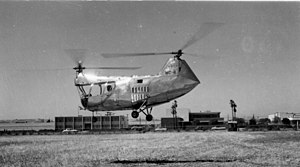McCulloch MC-4
| MC-4 | |
|---|---|

| |
| Role | Light helicopter |
| Manufacturer | McCulloch Aircraft Corporation |
| Designer | Drago Jovanovich |
| First flight | 1948 |
| Primary users | United States Army United States Navy |
| Developed from | HERC JOV-3 |
The McCulloch Model MC-4 was an American tandem-rotor helicopter and was the first helicopter developed by McCulloch Aircraft Corporation, a division of McCulloch Motors Corporation.[1] It was evaluated by the United States Army as the YH-30 and the United States Navy as the XHUM-1.
Design and development
The MC-4 was a larger version of the earlier HERC JOV-3 tandem-rotor helicopter and was developed by the McCulloch Aircraft Corporation. The JOV-3 was developed by Jovanovich when he headed the Helicopter Engineering and Research Corporation. The JOV-3 first flew in 1948. In 1949 Jovanovich moved to the McCulloch Motors Corporation where an enlarged helicopter the MC-4 first flew in March 1951. It was followed by a similar MC-4C and three evaluation helicopters for the United States Army (as the YH-30). The MC-4C was slightly larger than the MC-4. When the MC-4C was certified in 1953 it was the first tandem-rotor helicopter to be certified in the United States for commercial use. Three examples were evaluated by the United States Army as the YH-30, but the Army's evaluation showed the helicopter to be underpowered.[1]
The YH-30 had a steel tube framework with a light metal skin, A single 200 hp Franklin piston engine was horizontally mounted amidships and powered two intermeshing tandem rotors. It had a fixed-wheel tricycle landing gear with a castering nosewheel.
No civil or military orders were received and Jovanovich formed his own company, the Jovair Corporation, where he modified the MC-4C as a prototype for a four-seat private helicopter designated the Sedan 4E. The Sedan 4E was powered by 210 hp Franklin 6A-335 engine. A version with a turbocharged engine was designed as the Sedan 4ES and a more basic Sedan 4A for agricultural use. By 1965 a small number of Sedan helicopters were built. In the early 1970s McCulloch regained the rights to the helicopter designs.
Variants

- McCulloch MC-4
- Prototype with a 165 hp Franklin engine, two built, one for evaluation by the United States Navy.
- McCulloch MC-4A
- Variant for evaluation by the United States Navy as the XHUM-1, two built.
- McCulloch MC-4C
- Prototype with a 200 hp Franklin engine, one built and an additional three for United States Army evaluation as the YH-30.
- Jovair Sedan 4E
- Production civil four-seat version powered by a 210 hp Franklin 6A-335 engine.
- Jovair Sedan 4ES
- Sedan with a turbocharged 225 hp Franklin engine.
- Jovair Sedan 4A
- Simplified agricultural version.
Military designations
- YH-30
- Military version of the MC-4C, three built.
- XHUM-1
- Two MC-4As for evaluation by the United States Navy, later redesignated HUM-1.
Operators
Surviving aircraft
In 2008 two MC-4Cs were registered in the United States.
The Pima Air and Space Museum has a HUM-1, registration N4072K.
The Yanks American Air Museum at Chino is restoring a MC-4C to flying condition although there are no plans to fly it. It may be N4071K or N4091K. One of the three YH-30 military prototypes is preserved by the US Army Aviation Museum at Fort Rucker, Alabama. It is c/n 001 and has the military serial 52-5837. As of April 2013 it remains in a storage building and is not on public display. In December 2018, the Army's aircraft had completed much of its restoration and in January 2019, is on display at the Army Aviation Museum at Fort Rucker, Alabama.
Specifications (YH-30)
General characteristics
- Crew: two
- Length: 32 ft 0 in (9.75 m)
- Height: 9 ft 2 in (2.79 m)
- Empty weight: 1,200 lb (544 kg)
- Gross weight: 2,000 lb (907 kg)
- Powerplant: 1 × Franklin O-335-6 (6A4-200-C6) piston , 200 hp (147.1 kW)
- Main rotor diameter: 2 × 22 ft 0 in (6.71 m)
Performance
- Maximum speed: 105 mph (168.98 km/h, 91 kn)
- Range: 200 mi (321.86 km, 170 nmi)
References
- ^ a b Harding, Stephen U.S. Army Aircraft Since 1947, Airlife Publishing, Ltd. 1990. ISBN 1-85310-102-8
- John Andrade, U.S.Military Aircraft Designations and Serials since 1909, Midland Counties Publications, 1979, ISBN 0-904597-22-9 (Page 121)
- The Illustrated Encyclopedia of Aircraft (Part Work 1982-1985), 1985, Orbis Publishing, Page 2213/2214.
